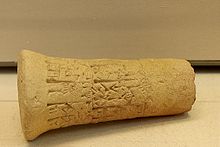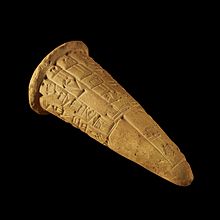- Clay nail
-
 One of the oldest diplomatic documents known, by King Entemena, c 2400 BC.
One of the oldest diplomatic documents known, by King Entemena, c 2400 BC.
Used by Sumerians and other Mesopotamian cultures beginning in the third millennium BC, clay nails, also referred to as dedication or foundation nails, were inscribed with cuneiform and embedded into walls to serve as evidence that the temple or building was the divine property of the god to whom it was dedicated.
Additionally, uninscribed clay cones painted in different colors were used by Sumerians to create decorative mosaic patterns on walls and pillars within buildings, as well as to add strength to the structure (see 2nd link below).
The similar funerary cones of ancient Egypt used the cone base as the major writing surface.
Contents
Foundation nail examples
As some of the oldest 'documents' in history, the sponsor, responsible for the construction, or dedication of a work, some of the oldest histories, and/or intrigues are recorded. (Boasting sometimes led to historical inaccuracies, or mistatements of facts.)
King Entemena
King Entemena's nail is a prime example of a clay nail in excellent condition, as well as a detailed story. He was king of Lagash towards the late-middle of the 3rd millennium BC.
See also
External links
- http://www.etc.cmu.edu/projects/i4i/photos/nail.html
- http://www.metmuseum.org/toah/hd/uruk/hod_L.1995.48.2.htm
Categories:- Mesopotamian mythology
- Archaeology of the Near East
- Ancient Near East art and architecture
- Archaeological artefact types
- Ancient Near and Middle East clay objects
- 3rd-millennium BC works
- Archaeology stubs
Wikimedia Foundation. 2010.

